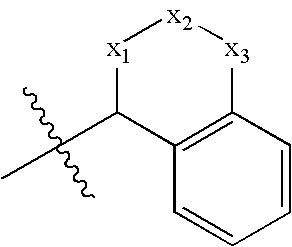Benzamide 2-hydroxy-3-diaminoalkanes
a technology of diaminoalkane and benzamide, which is applied in the field of benzamide 2hydroxy3diaminoalkane, can solve the problems of no effective treatment for halting, preventing, or reversing the progression of alzheimer's disease, and achieving the effects of inhibiting the production of a-beta peptides, preventing the potential consequences of alzheimer's disease, and preventing beta-secreta
- Summary
- Abstract
- Description
- Claims
- Application Information
AI Technical Summary
Benefits of technology
Problems solved by technology
Method used
Image
Examples
chemistry examples
[0498]The following abbreviations may be used in the Examples:
[0499]EDC stands for 1-(3-dimethylaminopropyl)-3-ethylcarbodiimide or the hydrochloride salt;
[0500]DIEA stands for diisopropylethylamine;
[0501]PyBOP stands for benzotriazol-1-yloxy)tripyrrolidinophosphonium hexafluorophosphate;
[0502]HATU stands for O-(7-azabenzotriazol-1-yl)-1,1,3,3-tetramethyluronium hexafluorophosphate;
[0503]THF stands for tetrahydrofuran;
[0504]EtBz stands for ethylbenzene;
[0505]DCM stands for dichloromethane.
example 1
1-(3-Ethyl-phenyl)-cyclohexanol from 1-bromo-3-ethylbenzene
[0506]
[0507]Magnesium turnings (1.35 g, 55.53 mmol) were activated via vigorous stirring overnight under N2 (g) inlet. A few crystals of iodine were added to the flask, which was then flamed-dried under vacuum. Anhydrous THF (3 mL) was added to the reaction flask followed by 1-bromo-3-ethylbenzene (Avocado, 2.0 mL, 14.59 mmol). The reaction was initiated after briefly heating with a heat gun. To this was added the remainder of 1-bromo-3-ethylbenzene (1.7 mL, 12.43 mmol) in a THF solution (15 mL). The reaction mixture was refluxed for 2 h. A cyclohexanone (2.2 mL, 21.22 mmol) in THF (8 mL) solution was added once the flask was cooled to 0° C. After 3.5 h the reaction mixture was quenched with H2O over an ice bath and partitioned between Et2O and H2O. The organic layer was removed and acidified with 1N HCl. The organic layer was separated, dried (Na2SO4), and concentrated under reduced pressure. The residue was purified by fla...
example 2
1-(1-Azido-cyclohexyl)-3-ethyl-benzene from 1-(3-Ethyl-phenyl)-cyclohexanol
[0508]
[0509]1-(3-Ethyl-phenyl)-cyclohexanol (4.02 g, 19.68 mmol) in anhydrous chloroform (45 mL) was cooled to 0° C. under N2 (g) inlet. Sodium azide (3.97 g, 61.07 mmol) was added followed by dropwise addition of trifluoroacetic acid (7.8 mL, 101.25 mmol). The reaction mixture was refluxed for 2 h and allowed to stir at rt o / n. This was then partitioned between H2O and Et2O. The aqueous layer was removed and the mixture was washed with H2O followed by 1.0N NH4OH. The organic layer was separated, dried (Na2SO4), and concentrated under reduced pressure. The crude product was used without further purification (3.30 g, 73%): mass spec (CI) 187.1 (M-42).
PUM
| Property | Measurement | Unit |
|---|---|---|
| temperature | aaaaa | aaaaa |
| temperature | aaaaa | aaaaa |
| temperature | aaaaa | aaaaa |
Abstract
Description
Claims
Application Information
 Login to View More
Login to View More - R&D
- Intellectual Property
- Life Sciences
- Materials
- Tech Scout
- Unparalleled Data Quality
- Higher Quality Content
- 60% Fewer Hallucinations
Browse by: Latest US Patents, China's latest patents, Technical Efficacy Thesaurus, Application Domain, Technology Topic, Popular Technical Reports.
© 2025 PatSnap. All rights reserved.Legal|Privacy policy|Modern Slavery Act Transparency Statement|Sitemap|About US| Contact US: help@patsnap.com



